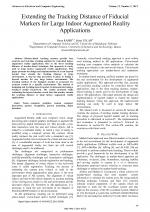| 2/2015 - 8 |
Extending the Tracking Distance of Fiducial Markers for Large Indoor Augmented Reality ApplicationsRABBI, I. |
| Extra paper information in |
| Click to see author's profile in |
| Download PDF |
Author keywords
computer graphics, human computer interaction, pattern recognition, pattern matching, object detection
References keywords
reality(17), augmented(11), marker(8), virtual(7), tracking(7), applications(5)
Blue keywords are present in both the references section and the paper title.
About this article
Date of Publication: 2015-05-31
Volume 15, Issue 2, Year 2015, On page(s): 59 - 64
ISSN: 1582-7445, e-ISSN: 1844-7600
Digital Object Identifier: 10.4316/AECE.2015.02008
Web of Science Accession Number: 000356808900008
SCOPUS ID: 84979834518
Abstract
Marker-based tracking systems provide fast, accurate and real-time tracking solution for controlled indoor augmented reality applications. Due to the short tracking distance of marker-based technique, this approach is rarely used in large indoor augmented reality applications. This paper presents the design and implementation of a new layered marker that extends the tracking distance to large environment. A step by step procedure is given to design a layered marker for any large indoor environment. The tracking method of the designed marker is presented for accurate results in a specific environment. The method of designing and tracking layered marker is demonstrated using a standard toolkit framework. The results produced while evaluating the layered marker reveal that this marker extends the tracking distance to large indoor augmented reality applications. |
| References | | | Cited By |
Web of Science® Times Cited: 7 [View]
View record in Web of Science® [View]
View Related Records® [View]
Updated 3 weeks, 5 days ago
SCOPUS® Times Cited: 10
View record in SCOPUS® [Free preview]
View citations in SCOPUS® [Free preview]
[1] SkyroadAR: An Augmented Reality System for UAVs Low-Altitude Public Air Route Visualization, Tan, Junming, Ye, Huping, Xu, Chenchen, He, Hongbo, Liao, Xiaohan, Drones, ISSN 2504-446X, Issue 9, Volume 7, 2023.
Digital Object Identifier: 10.3390/drones7090587 [CrossRef]
[2] Hope Has Augmented Reality Applications in Science Education Improved Academic Achievement? An Experimental Study, Varlık, Savaş, Journal of Computer and Education Research, ISSN 2148-2896, Issue 24, Volume 12, 2024.
Digital Object Identifier: 10.18009/jcer.1425840 [CrossRef]
[3] A fuzzy rule based effective feature selection approach for augmented reality, Rajendra Thilahar, C., Sivaramakrishnan, R., Journal of Intelligent & Fuzzy Systems, ISSN 1064-1246, Issue 4, Volume 38, 2020.
Digital Object Identifier: 10.3233/JIFS-191674 [CrossRef]
[4] Gestures and marker based low-cost interactive writing board for primary education, Rehman, Inam Ur, Ullah, Sehat, Multimedia Tools and Applications, ISSN 1380-7501, Issue 1, Volume 81, 2022.
Digital Object Identifier: 10.1007/s11042-021-11366-1 [CrossRef]
[5] 2D Drawing Visualization Framework for Applying Projection-Based Augmented Reality in a Panelized Construction Manufacturing Facility: Proof of Concept, Ahn, SangJun, Han, SangUk, Al-Hussein, Mohamed, Journal of Computing in Civil Engineering, ISSN 0887-3801, Issue 5, Volume 33, 2019.
Digital Object Identifier: 10.1061/(ASCE)CP.1943-5487.0000843 [CrossRef]
Disclaimer: All information displayed above was retrieved by using remote connections to respective databases. For the best user experience, we update all data by using background processes, and use caches in order to reduce the load on the servers we retrieve the information from. As we have no control on the availability of the database servers and sometimes the Internet connectivity may be affected, we do not guarantee the information is correct or complete. For the most accurate data, please always consult the database sites directly. Some external links require authentication or an institutional subscription.
Web of Science® is a registered trademark of Clarivate Analytics, Scopus® is a registered trademark of Elsevier B.V., other product names, company names, brand names, trademarks and logos are the property of their respective owners.
Faculty of Electrical Engineering and Computer Science
Stefan cel Mare University of Suceava, Romania
All rights reserved: Advances in Electrical and Computer Engineering is a registered trademark of the Stefan cel Mare University of Suceava. No part of this publication may be reproduced, stored in a retrieval system, photocopied, recorded or archived, without the written permission from the Editor. When authors submit their papers for publication, they agree that the copyright for their article be transferred to the Faculty of Electrical Engineering and Computer Science, Stefan cel Mare University of Suceava, Romania, if and only if the articles are accepted for publication. The copyright covers the exclusive rights to reproduce and distribute the article, including reprints and translations.
Permission for other use: The copyright owner's consent does not extend to copying for general distribution, for promotion, for creating new works, or for resale. Specific written permission must be obtained from the Editor for such copying. Direct linking to files hosted on this website is strictly prohibited.
Disclaimer: Whilst every effort is made by the publishers and editorial board to see that no inaccurate or misleading data, opinions or statements appear in this journal, they wish to make it clear that all information and opinions formulated in the articles, as well as linguistic accuracy, are the sole responsibility of the author.



